THE APARTMENT HOUSE, 1965
JEFFREY SMART
oil on board
59.0 x 69.0 cm
signed and dated lower right: Jeffrey Smart 65
Macquarie Galleries, Sydney
Private collection, Sydney
Jeffrey Smart, Galleria 88, Rome, 8 – 23 April 1965, cat. 5
Jeffrey Smart, Macquarie Galleries, Sydney, 29 September – 11 October 1965, cat.7
Quartermaine, P., Jeffrey Smart, Gryphon Books, Melbourne, 1983, p. 108, cat. 432
Creating a visual tension between the urban landscape and the natural environment, Jeffrey Smart elucidates the strength of modernity through the depiction of highways, bitumen and imposing concrete buildings. The elevation of prosaic objects and structures into significant forms that attract and delight the eye is Smart's forte, as demonstrated in The Apartment House, 1965. Here we are presented with a simple rural scene, a woman hanging out the washing in front of a block of apartments. Despite the seemingly simplistic content, the picture possesses a visual eloquence for which Smart is celebrated. The apartment house sits proud and aloof on the top of the hill; a beacon of urbanisation and a symbol of banal beauty. The precision and austerity of the building is contrasted against the gentle rolling landscape and the fluttering clothes. The building itself appears empty and the only suggestion of life is the dark figure of the woman attending to the laundry on the line.
The human figure is an important device throughout Smart's oeuvre, providing balance and perspective against the background. Many of his figures are kept at a distance and estranged from the viewer, sometimes their backs are turned towards us or perhaps their eyes are closed, creating a divide that we cannot breach as demonstrated in The Apartment House. The features of the woman are imperceptible and she is reduced to a silhouette, interrupting the landscape and intensifying the isolating overtones epitomised by characteristic Smart figures, as they are commonly 'solitary in spirit and in place, redolent with an air of stillness' His figures are, invariably, emotionally remote, distanced and wholly unengaged with either their surrounds or us, the viewer.'1
Smart is a master of structure and placement as every objects and forms are carefully positioned. In the picture on offer, light and shadows converge in the foreground whilst a sole figure and a lonely apartment block punctuate the landscape. The placement of the small hill obscures the panoramic view fencing in the foreground, leading our gaze to the peaking horizon and the mysteries of an unseen vista beyond, alluding to the unknown. We are left to question what we cannot see and our curiosity is heightened. Perhaps The Apartment House signifies the edge of an expanding urban sprawl, the shadows across the foreground also possibly representing domes and spires of man-made structures against the edge of a rustic way of life? These mechanisms have cemented Smart's position as one of Australia's most important modern artists and, as Edmund Capon discusses, there is only one Jeffrey Smart: 'He emulates nobody, and nobody emulates him 'at least with any degree of authenticity.'2
1. Capon, E., Jeffrey Smart Retrospective, Art Gallery of New South Wales, Sydney, 1999, p. 17
2. Ibid, p. 12
CASSI YOUNG
